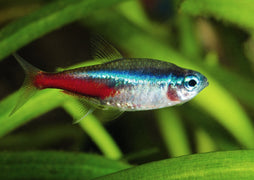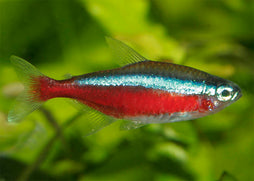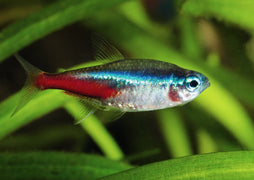Description
Hardy and easy to care for. This Tetra is relatively easy to breed even for the beginning aquarists. It is a schooling fish so best kept in a group. Avoid housing them in the same tank as smaller fish (particularly those with long, flowing fins) as Black Widows Longfin Tetra do occasionally nip.
These fish helm from several bodies of water in South America. They can be found in the Paraguay River Basin, throughout Brazil, and even in Argentina.
Features of Longfin Black Widow Tetra
- Distinctive black dorsal and anal fins, and by the vertical black stripes on the body.
-
The tail-fin is quite thin and features a forked shape.
-
They are peaceful fish and can be kept with other aquarium fish
-
The black widow tetra achieves its mature size at approximately one year
-
Care Level : Easy
The Best Aquarium Size for Tetras:
Being small fish, Black Widow Tetra is a schooling fish by nature, and best kept in groups of six or more. You need a minimum tank size of 30L to keep a small group of Black Widow Tetras.
You’ll likely need much larger tanks if you’re planning on introducing some tank mates and maybe even more Black Widow Tetras—usually, the bigger, the better. These fish are active swimmers, so you need to provide plenty of space to prevent overcrowding.
Tank Mate Compatibility:
A schooling fish by nature, the Black Widow Long-fin Tetras are best kept in groups of at least six or more. They make an excellent community fish due to their peaceful nature however they sometimes known to nip the fins of slower-moving fish, particularly those with long, flowing fins such as Bettas or Angelfish.
Here’s a list of some of the best tank mates for your Black Widow Long-fin Tetras:
Feeding :
Black widow tetras long-fin readily accept virtually any food, including live, fresh, frozen, freeze-dried, or flake foods. For the breed's optimal health, provide a variety of foods, which can include high-quality flake foods, brine shrimp, and any type of worms, as well as vegetable supplements and spirulina.
Many Tetras are omnivorous and will readily take most types of aquarium foods used in the hobby. Due to the small size of many species, ensure that food particles are not too large for their small mouths.
Tetra Tank Set-up:
Heater :
The temperature of your Tetra’s tank should match that of its native environment. Ideal water temperatures sit between at a stable number between 20 ⁰C - 26 ⁰C.
Light :
You can choose to use lighting in your aquarium if that’s what you prefer. Tetras spend most of their time in shaded waters in their natural habitat. To imitate that in captivity, dim lighting would be ideal. LED lights will provide the most customization and allow you to adjust the intensity until you reach the sweet spot.
Substrate :
Gravel and Dark Color Substrates.
Plants for Tetras:
They are accustomed to medium to large plants in their natural habitat and enjoy a well-planted aquarium with some open swimming space.
Decorations for Tetras:













